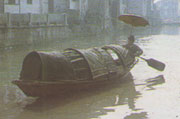|
Swordswoman's Hometown-Jianhu Lake of Shaoxing
 The Jianhu lake is located in the southwestern part of Shaoxing County with the coordinates, latitude 29กใ58' N, longitude 120กใ14' E. It is the remains of Gujianhu, famous historical water irritation project over the south of the Yangtze River, sharing several names such as Changhu, Dahu, Qinghu, Hejianhu, etc. The Jianhu lake is located in the southwestern part of Shaoxing County with the coordinates, latitude 29กใ58' N, longitude 120กใ14' E. It is the remains of Gujianhu, famous historical water irritation project over the south of the Yangtze River, sharing several names such as Changhu, Dahu, Qinghu, Hejianhu, etc.
 Ma Zhen, governor of Huiji region, directed the construction which covered over 200 square kilometers in line with the local geographic feature in A.D.140 . The perimeter was 170 kilometers. This project benefited thousands of hectares of field until Song Dynasty when dykes were built to turn the lake into fields. The lake greatly shrank. Today's Jianhu Lake normally refers to the river system from the East Kuahu Bridge in the west of Shaoxing to the West Kuahu Bridge in Hutang Town, about 2.4 square kilometers in circumference. It is 23 kilometers long and 108 meters wide and 2.77 meters deep on average. The maximum width is 300 meters. Ma Zhen, governor of Huiji region, directed the construction which covered over 200 square kilometers in line with the local geographic feature in A.D.140 . The perimeter was 170 kilometers. This project benefited thousands of hectares of field until Song Dynasty when dykes were built to turn the lake into fields. The lake greatly shrank. Today's Jianhu Lake normally refers to the river system from the East Kuahu Bridge in the west of Shaoxing to the West Kuahu Bridge in Hutang Town, about 2.4 square kilometers in circumference. It is 23 kilometers long and 108 meters wide and 2.77 meters deep on average. The maximum width is 300 meters.
The lake, enclosed by green hills and with bridges and fishing boats on its mirror-like water, is typical region of rivers and lakes to the south of the Yangtze River. Wang Xizhi, one famous calligrapher wrote, "the person walking along the river is just like in the mirror."
The water is rich in calcium and lithium which is favorable for the natural fermentation and helps to distinguish the Shaoxing Rice wine from other rice wines. It has won unanimous praises from consumers both home and abroad.
Shaoxing, 60 kilometers south of Hangzhou shares long history, which was the capital of Yue kingdom in the Spring and Autumn Period. At the beginning of South Song Dynasty, Emperor Zhao Gou fled here and changed its original name, Yuezhou, into Shaoxing, which was adopted as its current name.
 Shaoxing is a home of celebrities, Wang Xizhi, the famous calligrapher in East Jing Dynasty;Lu You, the patriotic poet in South Song Dynasty; Xu Wei, the famous artist in Ming Dynasty; Qiu Jin, the revolutionary martyrs in late Qing Dynasty; Lu Xun, the revolutionary writer and thinker, and Zhou Enlai, the late Chinese Premier. Shaoxing is a home of celebrities, Wang Xizhi, the famous calligrapher in East Jing Dynasty;Lu You, the patriotic poet in South Song Dynasty; Xu Wei, the famous artist in Ming Dynasty; Qiu Jin, the revolutionary martyrs in late Qing Dynasty; Lu Xun, the revolutionary writer and thinker, and Zhou Enlai, the late Chinese Premier.
No. 23 of Hechang House, located at the foot of Tashan Mountain, is a former residence of Qiu Jin who ever spent her childhood and also the base of revolution since 1906 when she came back from Japan. Dr. Sun Yat-sen praised her the Woman Warrior of China. Premier Zhou wrote " never forgetting Qiu Jin and devoting to the new China."
Yangcheng Lake-the battle field in the past <<
Liangshan Lake--a base area for the peasants' insurrectionary army >>
|